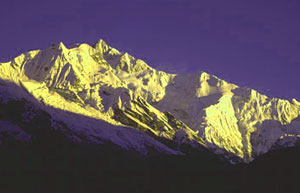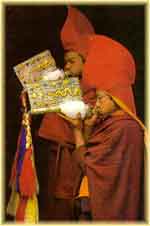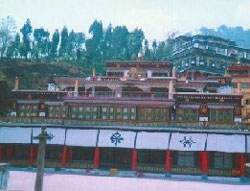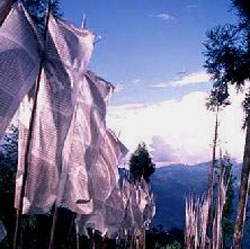|
Travelogues Sikkim: Footprints In The Snow
|
|||||||||||||||||||||||||||
There is one thing in common about all holidays in India : the moment you arrive you are being sold something. At the airport in Bagdogra it isn't seedy little hotels on offer, but cabbies wanting to take you for a ride. Heading straight for the Sikkim Tourism counter, the impassive face there states, "It is a bargaining rate to Gangtok." Probing further, we are told that Rs 500 is reasonable.
|
More About Sikkim • An Overview
Travelogues
Trekking | ||||||||||||||||||||||||||
Gangtok, the capital of Sikkim, has changed considerably in the 20 years since I last visited it. The evening is spent wandering up and down the length of the marketplace soaking in the ambience. The young women in graceful traditional dress or fashionable Western attire are remarkably attractive with a frank and bold expression that speaks of freedom. In contrast, the men are almost inconspicuous.
We sample authentic, exotic delicacies served in huge helpings. The other people in the restaurant are a group of 20 American women who are part of a package tour, and the odd scattered European, all of whom we continue to bump into over the next few days. We meet a Dutch national with a Scandinavian friend, visiting Sikkim for the fifth time, an Irishman who returns every few years and has seen and loved the length and breadth of India, and a British couple with clipped accent, diligently consulting their guide book. We walk up to the deer park, with it's imposing statue of the Buddha. It is disconcerting to find a snow leopard boxed in a tiny cage - is this the fleet-footed panther Peter Matthiessen sought a glimpse of in the Himalayan wilds as he wrote The Snow Leopard?
We walk to the monastery adjoining the palace, though the sign clearly reads, "No Visitors". The guard warns us not to wander towards the palace, standing in isolated and lifeless splendour, and not to take photographs of the palace. Perambulating around the monastery are some 200 Bhutias, prayer wheel or beads in hand, picking up pebbles or replacing them, as they chant with single-minded focus.
At noon we drive down to the Institute of Tibetology, a renowned centre for the study of Buddhist philosophy and religion, with rare tankha, statues and Buddhist icons. On display is a kapali, or pot made from a human skull, a pair of damarus made from scalps, thigh-bone flutes, and malas or necklaces made with wood from the Bodhi tree, apart from various sacrificial instruments.
There are Lepcha manuscripts along with palm-leaf ones from Bengal and Orissa, coins and stamps, relics of Ashokan monks and a treasure trove of Tibetan books. The curator puts aside one of the 19 volumes of Prajnaparamita, or transcendental wisdom in 8000 verses that he is reading, to have an involved discussion with us. Tibetans in exile share a quiet dignified determination to reclaim their land.
We chat with the little boy monks at the monastery, as they play football and carrom, their round beaming faces, sparkling. In a corner room, some young monks are making wheat-flour prayer symbols, dipped in a red dye. At the press, two printers are laboriously hand-printing manuscripts.
Encircled by 108 prayer wheels, Do-Drul Chorten, built by Trulsi Rinpoche, head of the Nyingma order, is one of the most important stupas in Sikkim. As the sun sets, monks in full ceremonial dress with elaborate head gear, perform rituals and ceremonies which are fascinating to watch. In a nearby prayer hall, another order of young monks recite liturgies in sing-song monotony, interspersed with the beating of drums and the blowing of horns. The master walks around bending to hear individual prayers recited like multiplication tables. An adolescent monk explains, "We belong to the red cap sect and are permitted to marry. We spend nine years as novices."
At Gangtok, there is an orchid festival in which many of the state's 600 species of unbelievably beautiful, rare and exotic orchids are on display.
Having studied in Chandigarh, and St. Stephen's College, Delhi, he laments, "I used to feel left out there. With our kind of faces, it is difficult to be accepted and integrate. We were called Chinks." It is an irony indeed that Tibetans in exile should be called Chinks, and that the xenophobia most of us suffer from in one form or another should preclude our humanity.
Overnight, posters are splattered on walls and cars. They read, "Stop Chinese population transfer to Tibet," "Chinese, Quit Tibet," and "Save Tibet, Free Tibet."
We walk up to the Enchey Monastery, built in 1909 at the spot where Lama Druptob Karpo had built a small hermitage for meditation. The lama was a Tantric master, known for his extraordinary powers of flying, and is believed to have flown from Mainom in South Sikkim to the hilltop where this monastery now stands. Enchey, meaning the place of solitude, is a monastery of the Nyingma order.
These are the Himalayan regions where anchorites and mystics have always lived. Here, naljorpas practice the art of tumo which enables them to keep warm in winter at heights of 10,000 feet in near naked condition. On other occasions I have met yogis clad in a single cotton garment in the snow-bound Himalayan regions.
Stories abound of tulkus, regarded as phantom forms created by the power generated in a state of perfect concentration of the mind. When a lama tulku dies, his disciple monks search for his reincarnate, and there are fairly elaborate practices and procedures to determine the reincarnation of a high-ranking tulku. The practice and celebration of chod, a strange and esoteric sacrificial rite, is replete with austere symbolism. Lung-gompas have been known to accomplish long-distance tramps at incredible speeds in trance-like states.
A visit in a four-wheel drive to the frozen Chango lake at 12,400 feet above sea level is the closest we are permitted to go to the border. In this white world, little snowflakes drifting down herald the snowfall to follow. A delightful experience. Tramping in the frozen ice, we are mesmerised by the splendour and the silence. Blanketed in white, there is nothing visible but a couple of shacks where piping hot tea is brewing. On the drive back, the haiku nature of the mountain side leaves an indelible impression.
What we leave for our next visit is a trip to northern Sikkim, and a visit to Pemayangste monastery, impossible to access at this time of year. And perhaps, some day, we will be able to follow the old route into Tibet.
|
|||||||||||||||||||||||||||
Editor: Romola Butalia (c) India Travelogue. All rights reserved. |
|||||||||||||||||||||||||||
 Something about the crisp mountain air is always rejuvenating. We stop for lunch at a wayside restaurant at Singtam, absorbing the laid-back atmosphere. The momos or mince meat dumplings, are a great appetiser, and we hungrily wolf down a mixture of Chinese and Sikkimese cuisine.
Something about the crisp mountain air is always rejuvenating. We stop for lunch at a wayside restaurant at Singtam, absorbing the laid-back atmosphere. The momos or mince meat dumplings, are a great appetiser, and we hungrily wolf down a mixture of Chinese and Sikkimese cuisine.

 After a night's rain, Khangchendzonga, the guardian deity of Sikkim, is clearly visible as the sun's first rays tinge the silver, glistening peaks with a golden hue.
After a night's rain, Khangchendzonga, the guardian deity of Sikkim, is clearly visible as the sun's first rays tinge the silver, glistening peaks with a golden hue.
 In a huge, tented structure, dank, dingy and with a stale odour no amount of incense can overpower, entire families sit praying and talking. I am inexorably drawn towards the chanting lamas, and the old men and women, their plaited hair tied around their heads, their weather-beaten faces etched with furrows. As a child these sights, sounds and smells were deeply distressing and frighteningly alien, but I have since exorcised my ghosts and perceive an amazing profound meditative absorption in these people, seemingly unaware of strangers in their midst. As we walk around the monastery the air reverberates with the sound of Om Mane Padme Hum, the great mantra dedicated to Avalokiteshwara, the Bodhisatva of Compassion.
In a huge, tented structure, dank, dingy and with a stale odour no amount of incense can overpower, entire families sit praying and talking. I am inexorably drawn towards the chanting lamas, and the old men and women, their plaited hair tied around their heads, their weather-beaten faces etched with furrows. As a child these sights, sounds and smells were deeply distressing and frighteningly alien, but I have since exorcised my ghosts and perceive an amazing profound meditative absorption in these people, seemingly unaware of strangers in their midst. As we walk around the monastery the air reverberates with the sound of Om Mane Padme Hum, the great mantra dedicated to Avalokiteshwara, the Bodhisatva of Compassion.
 The Rumtek Monastery, 24 kms away is the seat of the Kagyu order, and is a close replica of the original in Tibet. At the institute for Higher Buddhist Studies is a temple with a grand golden statue of the Buddha flanked by Manjushree and Karmapa.
The Rumtek Monastery, 24 kms away is the seat of the Kagyu order, and is a close replica of the original in Tibet. At the institute for Higher Buddhist Studies is a temple with a grand golden statue of the Buddha flanked by Manjushree and Karmapa.
 That evening dinner is at a cheerful little restaurant where we have been attracted by the strains of 70's muisc. The owner chats happily, "My parents came away from Tibet in 1959 and met in Sikkim. I correspond with several aunts and uncles who are still there, but they are strangers really." Letters take two to three moths to reach and are frequently censored. He informs us that 75% of the population of Tibet is now Chinese. Like many Tibetans he fears the loss of their rich and ancient cultural traditions and the growing influence of the Chinese on young Tibetans. Like other Tibetans, he believes that the Dalai Lama has succeeded in preserving the cultural identity of their people in exile.
That evening dinner is at a cheerful little restaurant where we have been attracted by the strains of 70's muisc. The owner chats happily, "My parents came away from Tibet in 1959 and met in Sikkim. I correspond with several aunts and uncles who are still there, but they are strangers really." Letters take two to three moths to reach and are frequently censored. He informs us that 75% of the population of Tibet is now Chinese. Like many Tibetans he fears the loss of their rich and ancient cultural traditions and the growing influence of the Chinese on young Tibetans. Like other Tibetans, he believes that the Dalai Lama has succeeded in preserving the cultural identity of their people in exile.
 Walking up a steep, secluded, wooded pathway we reach Ganesh Top, from where Gangtok can be seen sprawling below. The walk to Tashi View Point affords a spectacular view of Khangchendzonga and Siniolchu peaks. Ubiquitous prayer flags flutter in the wind.
Walking up a steep, secluded, wooded pathway we reach Ganesh Top, from where Gangtok can be seen sprawling below. The walk to Tashi View Point affords a spectacular view of Khangchendzonga and Siniolchu peaks. Ubiquitous prayer flags flutter in the wind.